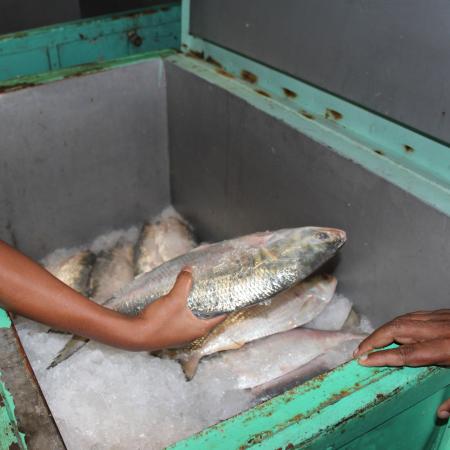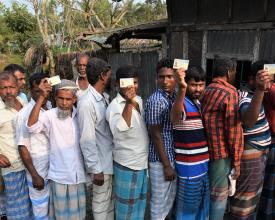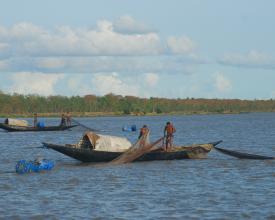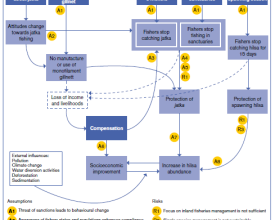
Gestión de la pesca de la hilsa en Bangladesh basada en incentivos

El sábalo hilsa (Tenualosa ilisha) es el pez nacional de Bangladesh y sustenta a más de 500.000 personas, sobre todo en las comunidades costeras. El Departamento de Pesca del gobierno bangladeshí utiliza una gestión basada en incentivos para proteger sus poblaciones de hilsa. En virtud del Plan de Acción para la Gestión de la Pesca de la Hilsa, se prohíbe la pesca durante varios meses al año en una serie de zonas costeras protegidas, y durante esos periodos se ofrece a las familias de pescadores afectadas una compensación en forma de arroz para mejorar su seguridad alimentaria y reponer los ingresos perdidos. A otros hogares afectados se les ofrece formación y apoyo para diversificar sus fuentes de ingresos. Esta distribución de beneficios, combinada con la cogestión adaptativa y actividades de concienciación sobre prácticas pesqueras sostenibles, pretende incentivar el cumplimiento de la normativa pesquera y mejorar las condiciones socioeconómicas de las familias de pescadores.
Contexto
Défis à relever
El sábalo hilsa tiene un enorme valor económico, social y cultural para Bangladesh. En la década de 1970, la producción de hilsa empezó a disminuir gradualmente, debido sobre todo a la sobrepesca y a la degradación del hábitat. Para frenar este declive, el gobierno introdujo varias normativas pesqueras que incluían prohibiciones estacionales de la pesca -tanto en todo el país como en zonas específicas de santuarios de la hilsa- con el objetivo de proteger a los juveniles y a la hilsa reproductora. Los pescadores artesanales de hilsa suelen padecer altos niveles de pobreza y vulnerabilidad, por lo que estas normativas pesqueras suponen un coste socioeconómico, sobre todo para quienes viven cerca de las zonas de santuario. La capacidad de control y aplicación de la normativa también es limitada.
Ubicación
Procesar
Resumen del proceso
Juntos, la compensación alimentaria y el apoyo a la generación de ingresos alternativos incentivan el cumplimiento de las normas de pesca de la hilsa, al compensar la pérdida de ingresos. En última instancia, se espera que este enfoque conduzca a una mejora socioeconómica de los hogares dedicados a la pesca de la hilsa y a un aumento de su abundancia.
Bloques de construcción
Compensación alimentaria
Durante las vedas de pesca estacionales, el gobierno distribuye sacos de arroz a una parte (unos 248.674) de los hogares afectados en 15 distritos. El plan se introdujo en 2004, con el objetivo principal de reducir la inseguridad alimentaria y la vulnerabilidad, pero también proporciona un incentivo para el cumplimiento de la normativa pesquera, al compensar los ingresos dejados de percibir durante las vedas. A partir de una investigación dirigida por el Instituto Internacional de Medio Ambiente y Desarrollo en colaboración con el Departamento de Pesca del gobierno de Bangladesh, el Centro de Estudios Avanzados de Bangladesh, el Instituto de Investigación Pesquera de Bangladesh y la Universidad Agrícola de Bangladesh, el plan se ha ampliado y rediseñado para aumentar su eficacia como incentivo económico. La cobertura de los hogares afectados se ha multiplicado por más de siete desde el inicio del plan, y las familias reciben ahora 40 kg de arroz al mes durante cuatro meses, frente a los 10 kg iniciales para uno a tres meses. También se han reducido los casos de asignación indebida de arroz gracias a la introducción de tarjetas de identificación para los pescadores.
Factores facilitadores
Para incentivar el cumplimiento, la compensación debe considerarse adecuada y suficiente para compensar o reducir los ingresos que se dejan de percibir por respetar las restricciones pesqueras estacionales. Por lo tanto, debe basarse en una investigación socioeconómica rigurosa.
El éxito de los incentivos también depende de la aceptación social, por lo que son esenciales las actividades de concienciación y sensibilización sobre la necesidad de prácticas pesqueras sostenibles y la importancia del cumplimiento de las restricciones pesqueras.
Lección aprendida
La compensación alimentaria puede haber tenido algunas consecuencias negativas imprevistas, como el impacto en los precios locales del arroz, los mercados laborales y los mercados de microfinanciación. Los sistemas de incentivos siempre deben investigar y tratar de mitigar estas consecuencias imprevistas.
También hay pruebas de que los terratenientes han obtenido beneficios desproporcionados, en lugar de los más vulnerables, los hogares de pescadores sin tierra con niveles de ingresos más bajos. Esta cuestión pone de relieve la necesidad de que los planes de incentivos incluyentes utilicen un sesgo sistemático y positivo a favor de los más necesitados.
Del mismo modo, las estructuras de poder locales han limitado el impacto de la concesión de compensaciones alimentarias a los hogares de pescadores. La dependencia de los pescadores de los intermediarios para obtener créditos limita su capacidad para dejar de pescar durante las vedas estacionales, porque siguen obligados a pagar sus deudas.
Ayudas alternativas para generar ingresos
Desde 2009, el gobierno ofrece apoyo (por ejemplo, formación, cursos de actualización y microcréditos) para ayudar a los pescadores a generar ingresos a partir de medios de vida alternativos, como la cría de ganado y las pequeñas empresas. Desde 2015, WorldFish ha estado trabajando con el gobierno para mejorar este enfoque en comunidades seleccionadas a través de un proyecto llamado "Pesca costera mejorada en Bangladesh" (ECOFISH-BD). Por ejemplo, el proyecto ha establecido Grupos de Ahorro Comunitario (GAC) para las mujeres de estas comunidades con el fin de mejorar los comportamientos de ahorro de los hogares pesqueros. Sus miembros reciben formación financiera y sobre la importancia de la gestión sostenible de la pesca de la hilsa para su sustento y bienestar. Se les anima a ahorrar 100 BDT (poco más de 1 dólar estadounidense) cada mes, y cuando un CSG alcanza un objetivo de ahorro de 25.000 BDT, ECOFISH iguala el ahorro. Se espera que esto incentive un mayor ahorro y mejore la posición socioeconómica de los hogares de pescadores, de modo que sean más capaces de cumplir las restricciones pesqueras y diversificar sus medios de vida.
Factores facilitadores
El éxito de los incentivos en forma de apoyo a la diversificación de los medios de subsistencia depende de la identificación de tipos de apoyo adecuados y socialmente aceptables. A su vez, esto requiere evaluaciones rigurosas y participativas de las necesidades y preferencias de la comunidad.
Lección aprendida
El apoyo gubernamental a la generación de ingresos alternativos tuvo una aceptación y un impacto limitados debido a la falta inicial de participación de las partes interesadas y de evaluación de las necesidades. ECOFISH-BD ha abordado esta cuestión identificando tipos de ayuda más apropiados y estableciendo las instituciones locales y los sistemas de cogestión adaptables necesarios para apoyar la diversificación de los medios de subsistencia, pero aún está por ver si estas políticas e instituciones sobrevivirán más allá de la duración del proyecto.
También hay pruebas de que los propietarios de las tierras han obtenido beneficios desproporcionados, en lugar de los hogares de pescadores más vulnerables, sin tierras y con los niveles de ingresos más bajos. Esta cuestión pone de relieve la necesidad de que los planes de incentivos incluyentes utilicen un sesgo sistemático y positivo a favor de los más necesitados.
Medidas reglamentarias
El gobierno de Bangladesh gestiona la pesca artesanal de la hilsa con diversas medidas reguladoras, la mayoría de las cuales se centran en la protección de los juveniles:
- La pesca de la hilsa está prohibida en todo el país durante la temporada alta de reproducción (22 días en octubre), con el fin de minimizar las perturbaciones en el desove y el reclutamiento. La aplicación de la ley se centra en zonas conocidas por ser importantes para el desove.
- Entre noviembre y julio se prohíbe en todo el país durante ocho meses la captura, posesión, venta y transporte de juveniles de hilsa (alevines de menos de 25 cm) para maximizar el reclutamiento de juveniles a la pesquería. La aplicación se centra en 7.000 kilómetros cuadrados de zonas costeras, estuarinas y fluviales.
- El uso y la producción de redes de enmalle de monofilamento están prohibidos durante todo el año, también para proteger a los juveniles de hilsa.
- Se han designado seis santuarios de la hilsa para proteger las principales zonas de cría. Estos santuarios abarcan tramos de río de entre 20 y 100 km. En estas zonas está prohibida la pesca durante al menos dos meses en los periodos de mayor presencia de juveniles.
Un equipo de "tribunales móviles" trabaja a nivel de subdistrito para hacer cumplir estas normas, con el apoyo de la policía y otros organismos.
Factores facilitadores
El control y la aplicación eficaces de la normativa pesquera dependen de los recursos humanos, físicos y financieros, pero éstos son limitados en Bangladesh. En lugar de un control y una aplicación adecuados, la concesión de compensaciones permite e incentiva a los pescadores a cumplir estas normativas compensando o reduciendo el coste socioeconómico.
Lección aprendida
La normativa debe basarse en investigaciones ecológicas y biológicas sólidas si se quiere que tenga un impacto positivo en las poblaciones de hilsa. La ubicación geográfica y los calendarios estacionales de los reglamentos destinados a proteger a la hilsa se han ido adaptando con el tiempo en respuesta a las nuevas pruebas científicas.
Impactos
El enfoque de gestión basado en incentivos ha tenido un impacto socioeconómico directo en las comunidades pesqueras de hilsa de Bangladesh. Al menos 248.674 familias de pescadores han recibido entre 20 y 40 kg de arroz al mes durante las vedas. Un número menor de hogares ha recibido ayudas para medios de subsistencia alternativos, lo que se ha demostrado que ha dado lugar a importantes ganancias en ingresos y activos.
La investigación sugiere que este enfoque de gestión ha contribuido a un aumento de la producción de hilsa de más del 100% en los últimos 15 años, lo que es indicativo de un aumento de la abundancia de hilsa. Este aumento de la productividad ha beneficiado aún más a los pescadores de hilsa a través de un aumento de los ingresos de la pesca. Aunque es difícil evaluar el impacto adicional de ofrecer incentivos para el cumplimiento de la normativa pesquera, en comparación con el uso exclusivo de la normativa, parece probable que los incentivos hayan contribuido a reducir la pesca en santuarios durante los periodos de veda. Es probable que las actividades de concienciación hayan reforzado este impacto.
Sin embargo, las pruebas del aumento de la productividad varían espacialmente, lo que sugiere que los cambios medioambientales adversos podrían estar ocultando o contrarrestando los beneficios de la gestión en algunas zonas. También hay pruebas de que las ayudas alimentarias y a los ingresos no siempre llegan a los pescadores más vulnerables ni ayudan lo suficiente a los que están atrapados en ciclos de endeudamiento.
Beneficiarios
Los beneficiarios directos de este enfoque de gestión son los hogares de las comunidades de pescadores artesanales de hilsa de 15 distritos de Bangladesh. Indirectamente, todos los pescadores de hilsa se benefician de esta gestión, incluidos los operadores industriales.
Objetivos de Desarrollo Sostenible
Historia

Cuando el gobierno de Bangladesh empezó a distribuir indemnizaciones a los pescadores de hilsa en 2004, la aportación de la comunidad fue muy escasa y, por tanto, su impacto limitado. En abril de 2013, el Instituto Internacional de Medio Ambiente y Desarrollo (IIED) inició un proyecto de cuatro años para rediseñar el enfoque mediante una rigurosa investigación socioeconómica y ecológica y la colaboración con el Departamento de Pesca del gobierno de Bangladesh. El IIED se asoció con el Centro de Estudios Avanzados y la Universidad Agrícola de Bangladesh, y el proyecto fue financiado por la Iniciativa Darwin del gobierno británico.
Al establecer desde el principio una relación de confianza con altos funcionarios del gobierno y trabajar con un grupo diverso de partes interesadas, los investigadores mostraron al gobierno cómo podía mejorar su enfoque, haciéndolo más eficiente, eficaz, equitativo y sostenible. También demostraron cómo la modificación del planteamiento podía tener beneficios económicos, además de sociales y ecológicos. Como resultado, el gobierno se comprometió a aumentar la cobertura de los incentivos, ampliar el periodo de compromiso y aumentar la cuantía de la ayuda proporcionada a los pescadores y pescadoras.
El éxito de este proyecto influyó en la ejecución conjunta por parte del Departamento de Pesca y WorldFish de una iniciativa de cinco años (2014-2019) financiada por USAID, denominada "Mejora de la pesca costera en Bangladesh (ECOFISH-BD)", cuyo objetivo general es mejorar la resiliencia del ecosistema del río Meghna y de las comunidades que dependen de la pesca costera en Bangladesh. Un componente clave de estos esfuerzos consistió en apoyar el acceso de las mujeres a los recursos y las tecnologías para la diversificación de los medios de subsistencia y la mejora de la resiliencia de la comunidad en los periodos de veda pesquera.
En conjunto, estas iniciativas han reforzado el enfoque basado en incentivos utilizado en Bangladesh, al disminuir las dificultades impuestas a las comunidades pesqueras vulnerables, y han contribuido a un aumento significativo de la productividad de la hilsa en todo el país.





